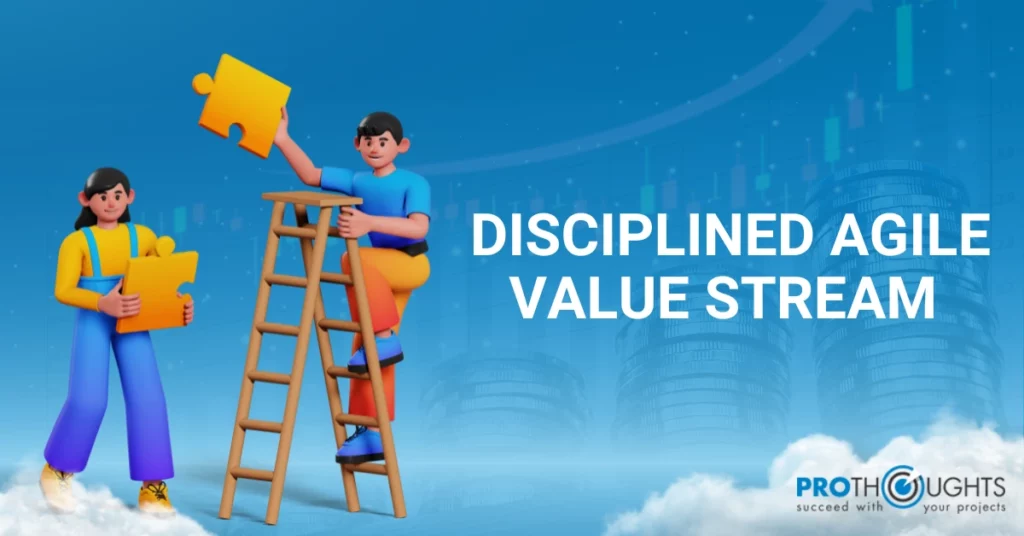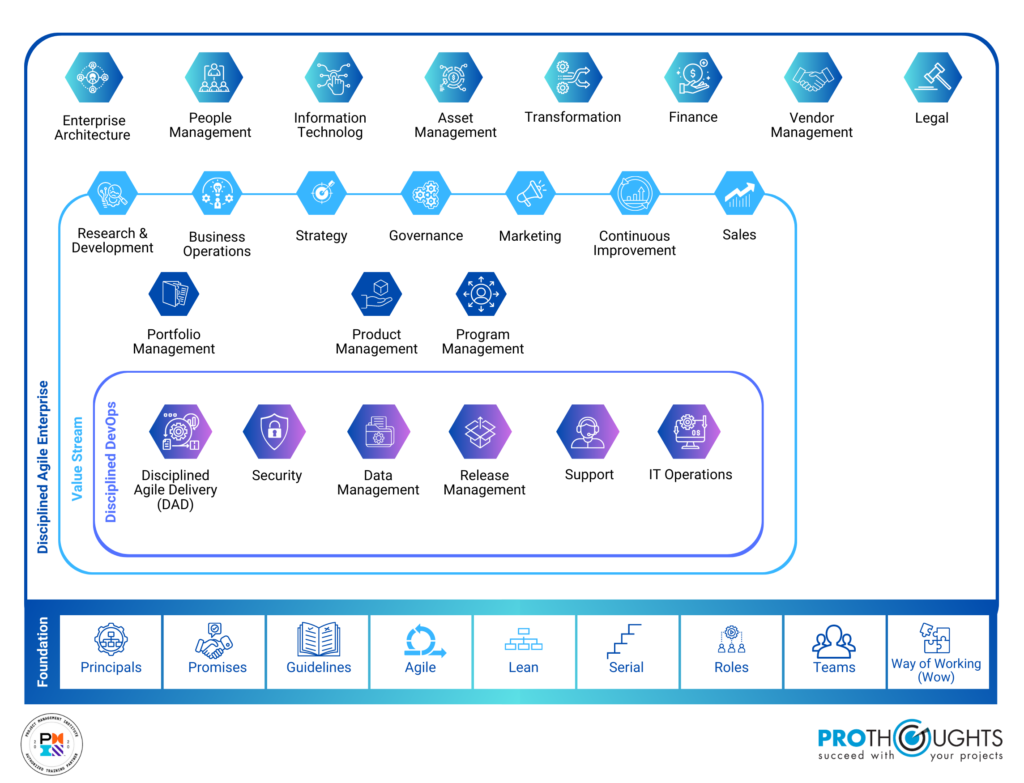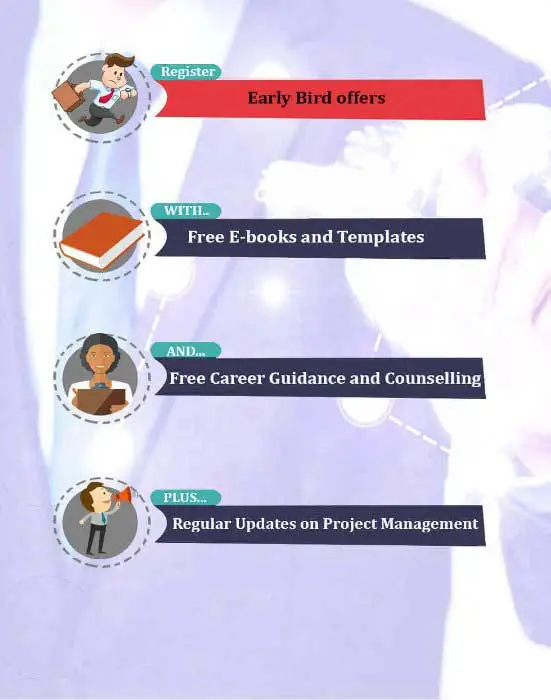
Disciplined Agile is a broad spectrum of practices and principles. It is rightly deemed as a mindset instead of a framework. As a mindset, it is fragmented into several layers. One of these layers forms the topic of this blog and the basis of the best master-level certification in Disciplined Agile — Disciplined Agile Value Stream. Here is a comprehensive guide that defines Value Stream in Disciplined Agile, the process blades in it, how to go about mapping and managing a value stream, and more. Let’s dive right in!
What Best Defines A Value Stream?
Value Streams are a part of the business architecture that describes how the end user receives value from an organization. Value Streams can be defined as a series of steps or activities that an organization follows to deliver valuable outcomes to its customers. This set of actions begins with conceptualizing a way to add value to a customer and ends with realizing the said value through business operations. Moreover, the steps include ideation, development, testing, deployment, and support. Therefore, Value Stream Analysis primarily focuses on optimizing the flow of work through the organization to ensure that value is delivered in the most effective and efficient way possible.
The Value Streams Layer In The Disciplined Agile Toolkit
The Value Streams Layer serves as the backbone of Disciplined Agile (DA), which guides the implementation of agile and lean practices at scale. It helps organizations efficiently identify, plan, and execute value delivery to their customers. The Value Stream layer extends the Disciplined DevOps layer and forms the foundation of the Disciplined Agile Enterprise layer as shown in the figure below. The Value Streams Layer ensures that teams work in harmony and align their efforts with business goals. Moreover, by focusing on the value delivered to customers, organizations can prioritize their work effectively and eliminate wasteful activities. Value Streams also enable continuous improvement and facilitate a proactive approach to meet changing market demands.

Process Blades In The Value Streams Layer
In the Value Streams layer of the Disciplined Agile Toolkit, various process blades play a crucial role in optimizing value delivery for an organization. These process blades encompass a range of essential business activities that significantly impact the disciplined agile value stream. The following process blades extend the Disciplined DevOps Layer in the Value Stream layer. Let’s delve into each of these process blades to understand their significance.
-
Business Operations
Business Operations form the backbone of any organization. This process blade includes all the day-to-day activities necessary to keep the business running smoothly. Further, it involves tasks related to finance, human resources, administration, and other operational functions that enable the organization to function effectively.
-
Continuous Improvement
Continuous improvement is a fundamental process blade that focuses on optimizing existing processes and practices. It involves regularly assessing the performance of various value streams and identifying areas for improvement. By fostering a culture of continuous improvement, organizations can stay competitive and enhance their overall efficiency.
-
Governance
Governance is a vital process mechanism that guarantees the organization’s compliance with regulations, policies, and standards. It entails defining decision-making procedures, establishing accountability, and offering a framework for aligning activities with the business’s strategic goals.
-
Marketing
The Marketing process blade is crucial in promoting products or services to prospective customers. This process blade encompasses various activities such as market research, advertising, branding, and customer engagement. Effective marketing strategies can significantly impact the success of value delivery to customers.
-
Portfolio Management
Portfolio Management involves making strategic decisions regarding the organization’s projects and initiatives. So, this process blade focuses on optimizing resource allocation, prioritizing projects, and aligning them with the organization’s long-term goals.
-
Product Management
Product Management deals with the end-to-end lifecycle of a product or service. This process blade includes activities like market analysis, product development, pricing, and product launch. Product Managers ensure that the products meet customer needs and contribute to overall value delivery.
-
Program Management
Program Management involves coordinating and overseeing the execution of related projects to achieve specific strategic objectives. Therefore, this process blade ensures effective communication and alignment between different projects within a program.
-
Research & Development
Research & Development (R&D) is a process blade dedicated to innovation and new product development. So, R&D teams work on exploring new ideas, technologies, and solutions that can lead to improved value offerings for customers.
-
Sales
Sales is a crucial process blade responsible for generating revenue by converting leads into customers. The Sales teams of an organization engage with potential clients, demonstrate the value of products or services, and negotiate contracts to drive business growth.
-
Strategy
The Strategy process blade focuses on setting the overall direction and vision for the organization. It involves defining long-term goals, assessing market opportunities, and formulating plans to achieve a competitive advantage.
What Is Value Stream Mapping?
Value Stream Mapping (VSM), also called Value Stream Analysis, is a powerful and visual technique used to analyze, understand, and optimize the flow of materials, information, and activities involved in delivering a product or service to customers. The consequently defined Value Stream Map provides a comprehensive overview of the end-to-end process, allowing organizations to identify inefficiencies, waste, and opportunities for improvement. In addition, the process of Value Stream Mapping involves creating a detailed and graphical representation of the entire value stream. This is typically done using flowcharts or diagrams that illustrate the various steps and interactions involved in the process. These diagrams constitute the Value Stream Map. Let’s define the term Value Stream Map and look at its specifics in the next section.
What Is A Value Stream Map?
A Value Stream Map is a commonly used tool in lean project management and process improvement methodologies to understand and optimize the end-to-end processes involved in creating value for the customer.
The Value Stream Map typically consists of the following elements:
- Process Steps: The map starts with a series of process steps or activities representing the various stages of producing or delivering the product or service. Further, these steps are usually represented as boxes or rectangles.
- Flow of Materials and Information: Arrows or lines connect the process steps, showing the flow of materials and information between them. Therefore, it helps identify how materials move through the process and how data is shared among different stages.
- Lead Time and Cycle Time: Lead time pertains to the total time it requires for a product or service to traverse the entire value stream, starting from the initial request until its ultimate delivery. Conversely, cycle time represents the duration it takes for a single unit to complete the entire process. Both lead time and cycle time are vital indicators for assessing process efficiency.
- Work in Progress (WIP): The amount of work in progress at each stage of the process is frequently included in Value Stream Maps. This enables teams to detect high WIP locations. As a result, teams can signal possible bottlenecks or inefficiencies.
- Data Boxes: Additional data boxes or information may be added to the map to provide more context. This can include key performance indicators (KPIs), such as defect rates, throughput, and customer satisfaction, to help evaluate the overall performance of the value stream.
How Does A DAVSC Conduct Value Stream Management?
A Disciplined Agile Value Stream Consultant (DAVSC) plays a crucial role in conducting Value Stream Management (VSM) to optimize an organization’s value delivery process. DAVSCs utilize their expertise in value stream analysis and improvement to drive positive organizational changes. Here’s how a DAVSC conducts Value Stream Management:
Step 1: Disciplined Agile Value Stream Consultant Understands the Current State:
The first step of Value Stream Management is to gain a deep understanding of the organization’s current value streams. DAVSCs collaborate with stakeholders, teams, and leaders to gather data, conduct interviews, and observe processes. Moreover, they use tools like Value Stream Mapping to visualize and analyze the flow of activities, resources, and information.
Step 2: Disciplined Agile Value Stream Consultant Identifies Inefficiencies and Bottlenecks:
With the current state clearly mapped out, DAVSCs identify inefficiencies, bottlenecks, and areas of waste within the value streams. In addition, they analyze data and metrics to pinpoint the root causes of these issues.
Step 3: Disciplined Agile Value Stream Consultant Develops the Future State Vision:
Based on the analysis, the DAVSC works with relevant stakeholders to develop a future state vision for the value streams. Subsequently, this vision encompasses improvements, process changes, and optimizations that address the identified issues and align with the organization’s strategic goals.
Step 4: Disciplined Agile Value Stream Consultant Defines Improvement Initiatives:
Once the future state vision is established, the DAVSC defines specific improvement initiatives and action plans to achieve the desired state. These initiatives may involve process redesign, automation, resource reallocation, or technology adoption.
Step 5: Disciplined Agile Value Stream Consultant Facilitates Collaboration and Alignment:
A critical aspect of Value Stream Management is ensuring collaboration and alignment among different teams and departments involved in the value streams. Therefore, DAVSCs facilitate discussions, workshops, and meetings to encourage cross-functional cooperation and a shared understanding of the improvement goals.
Step 6: Disciplined Agile Value Stream Consultant Implements and Monitors Changes:
DAVSCs guide the organization through the implementation of improvement initiatives. Further, they work closely with teams to ensure that changes are executed effectively and monitor the progress to measure the impact of the changes on the value streams.
Step 7: Disciplined Agile Value Stream Consultant Works On Continuous Improvement:
Value Stream Management is an iterative process. DAVSCs continuously review and assess the results of improvement initiatives. Moreover, they gather feedback, measure performance, and adapt their approach based on the outcomes. This iterative approach ensures that value streams are continually optimized and aligned with evolving business needs.
Step 8: Disciplined Agile Value Stream Consultant Coaches and Builds Capability:
Throughout the Value Stream Management journey, DAVSCs also play a coaching role. Since they provide guidance, mentorship, and knowledge transfer to the organization’s teams and leaders, it builds their capability to independently conduct future value stream improvements.
Step 9: Disciplined Agile Value Stream Consultant Drives Cultural Change:
In addition to the technical aspects, DAVSCs focus on driving cultural change within the organization. They promote a culture of continuous improvement, collaboration, and innovation, encouraging a mindset of value-driven decision-making.
About PMI’s Disciplined Agile Value Stream Consultant (DAVSC) Certification
The Project Management Institute (PMI) offers the Disciplined Agile Value Stream Consultant (DAVSC) certification to professionals seeking to enhance their expertise in value stream management. This certification equips individuals with the skills and knowledge to lead value-stream improvement initiatives and drive positive organizational changes. Moreover, with the proper DAVSC training, you can successfully conduct Value Stream Mapping and substantially improve value delivery to your customers and stakeholders. By focusing on value stream management, agile and lean practices, and organizational transformation, DAVSC-certified individuals can optimize value delivery processes and contribute to the organization’s success in the market.
ProThoughts is the leading institute across the globe that trains professionals to excel in their disciplined agile journey. We create leaders who can successfully conduct a thorough value stream analysis, optimize it for better value delivery, and also leads teams and organizations to success. Ranking amongst the top three globally, with DAVSC-certified instructors honing decades of project management experience, ProThoughts is the ideal choice for the final step in your Disciplined Agile certification journey. Still unsure? Let’s look at how a DAVSC-certified Value Stream Manager benefits an organization.
How Does A Certified Value Stream Manager Benefit An Organization?
A DAVSC-certified Value Stream Manager can bring significant benefits to an organization by leveraging their expertise and knowledge in optimizing value streams. This certification indicates that the individual has proficiency in implementing and improving value streams, which can lead to several advantages for the organization:
-
Enhanced Efficiency:
A DAVSC-certified Value Stream Manager is skilled in identifying inefficiencies, bottlenecks, and waste in value streams. They can use their knowledge to streamline operations, shorten lead times, and remove non-value-added activities. As a result, the workflow becomes more effective and productive, allowing the business to provide value to consumers faster and with fewer resources.
-
Improved Customer Satisfaction:
By focusing on optimizing value streams, the organization becomes more customer-centric. A DAVSC-certified Value Stream Manager understands the importance of delivering value that aligns with customer needs and expectations. Therefore, this customer-oriented approach can lead to higher customer satisfaction, fostering loyalty and positive word-of-mouth.
-
Data-Driven Decision Making:
Value Stream Managers use data and metrics to analyze and measure the performance of value streams. Consequently, their ability to gather and interpret data enables the organization to make informed decisions about process improvements and resource allocation, leading to more effective strategies and outcomes.
-
Reduced Costs:
Optimizing value streams can help reduce operational costs by eliminating wasteful activities and improving resource utilization. A DAVSC-certified Value Stream Manager can identify cost-saving opportunities and implement lean practices that contribute to overall cost reduction for the organization.
-
Agile and Adaptable Organization:
Value Stream Managers understand the importance of continuous improvement and adaptability. They can help instill a culture of agility within the organization, encouraging teams to embrace change, learn from experiences, and continuously evolve their processes. Consequently, this helps the organization stay competitive in a rapidly changing business environment.
-
Cross-Functional Collaboration:
Value Stream Managers promote collaboration among teams and departments involved in value delivery. By fostering better communication and coordination, they break down silos and create a more cohesive and collaborative work environment. As a result, there are smoother and more efficient value streams.
-
Sustainable Growth:
An organization with a certified Value Stream Manager can sustain its growth and success over the long term. So, by continuously optimizing value streams and adapting to market changes, the organization can remain resilient and agile in the face of challenges and opportunities.
-
Competitive Advantage:
A well-optimized value stream can become a significant competitive advantage for an organization. Thus, a DAVSC-certified Value Stream Manager’s expertise in creating efficient and effective value delivery processes can differentiate the organization from its competitors, attracting more customers and opportunities.
Conclusion
In conclusion, value streams form the backbone of efficient and customer-centric organizations. They enable businesses to streamline their processes, eliminate waste, and consistently deliver value to their customers. Value streams take center stage within the Disciplined Agile Toolkit, with skilled professionals like the DAVSCs and Value Stream Managers driving the journey toward continuous improvement. Embracing the power of value streams can undoubtedly lead organizations to a more sustainable and prosperous future.



